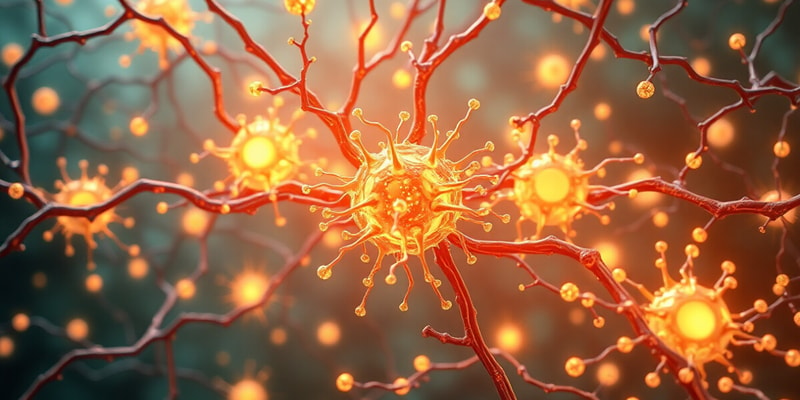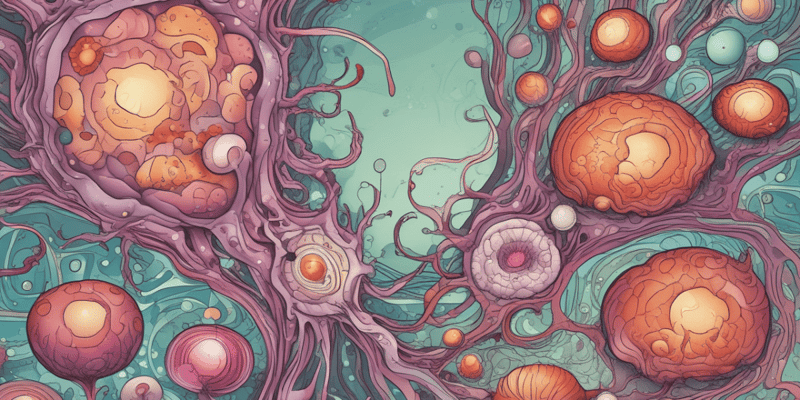Podcast
Questions and Answers
A ligand such as sugar, drug, or hormone opens the ligand-gated Na+ channel.
A ligand such as sugar, drug, or hormone opens the ligand-gated Na+ channel.
True
Na+ influx into the cell causes the membrane potential to decrease rapidly.
Na+ influx into the cell causes the membrane potential to decrease rapidly.
False
The activation of gated Na+ channels leads to the generation of a graded potential.
The activation of gated Na+ channels leads to the generation of a graded potential.
True
A decrease in extracellular Na+ would enhance the ligand-gated Na+ channel's opening.
A decrease in extracellular Na+ would enhance the ligand-gated Na+ channel's opening.
Signup and view all the answers
The membrane potential at rest is indicated as -70 mV.
The membrane potential at rest is indicated as -70 mV.
Signup and view all the answers
Ligand-gated channels for Na+ require a voltage change to open.
Ligand-gated channels for Na+ require a voltage change to open.
Signup and view all the answers
Calcium ions (Ca2+) are primarily responsible for the initial depolarization of sensory cells.
Calcium ions (Ca2+) are primarily responsible for the initial depolarization of sensory cells.
Signup and view all the answers
The influx of Na+ is an example of passive transport.
The influx of Na+ is an example of passive transport.
Signup and view all the answers
The maximum membrane potential reached during an action potential is +40 mV.
The maximum membrane potential reached during an action potential is +40 mV.
Signup and view all the answers
During the action potential, K+ channels open at a membrane potential of +30 mV.
During the action potential, K+ channels open at a membrane potential of +30 mV.
Signup and view all the answers
The Na+/K+ pump is responsible for maintaining a resting membrane potential of approximately +90 mV.
The Na+/K+ pump is responsible for maintaining a resting membrane potential of approximately +90 mV.
Signup and view all the answers
The inflow of Na+ during an action potential occurs due to a small Na+ gradient and weak electrical gradient.
The inflow of Na+ during an action potential occurs due to a small Na+ gradient and weak electrical gradient.
Signup and view all the answers
In the context of action potentials, Na+ channels close at the peak of the action potential.
In the context of action potentials, Na+ channels close at the peak of the action potential.
Signup and view all the answers
The influx of Na+ into the cell leads to a decrease in membrane potential.
The influx of Na+ into the cell leads to a decrease in membrane potential.
Signup and view all the answers
Voltage-gated Ca2+ channels open in response to a decrease in resting membrane potential.
Voltage-gated Ca2+ channels open in response to a decrease in resting membrane potential.
Signup and view all the answers
A large stimulus generates a larger amount of neurotransmitter release compared to a small stimulus.
A large stimulus generates a larger amount of neurotransmitter release compared to a small stimulus.
Signup and view all the answers
If the threshold of -55 mV is not reached, a high frequency of action potentials is generated along the axon.
If the threshold of -55 mV is not reached, a high frequency of action potentials is generated along the axon.
Signup and view all the answers
Neurotransmitters released from the presynaptic cell bind to postsynaptic receptors which can be either ligand-gated or voltage-gated channels.
Neurotransmitters released from the presynaptic cell bind to postsynaptic receptors which can be either ligand-gated or voltage-gated channels.
Signup and view all the answers
The membrane potential must reach -60 mV for a nerve impulse to be sent along the axon.
The membrane potential must reach -60 mV for a nerve impulse to be sent along the axon.
Signup and view all the answers
Calcium ions (Ca2+) play a crucial role in the fusion of neurotransmitter vesicles to the presynaptic membrane.
Calcium ions (Ca2+) play a crucial role in the fusion of neurotransmitter vesicles to the presynaptic membrane.
Signup and view all the answers
Graded potentials are always sufficient to trigger an action potential.
Graded potentials are always sufficient to trigger an action potential.
Signup and view all the answers
The arrival of an action potential triggers neurotransmitter release into the synapse.
The arrival of an action potential triggers neurotransmitter release into the synapse.
Signup and view all the answers
Sodium channels are primarily responsible for the repolarization phase of an action potential.
Sodium channels are primarily responsible for the repolarization phase of an action potential.
Signup and view all the answers
Nerve impulses travel at a speed of 360 km/h.
Nerve impulses travel at a speed of 360 km/h.
Signup and view all the answers
Copper wire transmits nerve impulses faster than 3 x 10^6 Km/h.
Copper wire transmits nerve impulses faster than 3 x 10^6 Km/h.
Signup and view all the answers
Diffusion occurs at a speed of 0.000000008 Km/h.
Diffusion occurs at a speed of 0.000000008 Km/h.
Signup and view all the answers
Nerve impulses are 4 x 10^10 times faster than the speed of diffusion.
Nerve impulses are 4 x 10^10 times faster than the speed of diffusion.
Signup and view all the answers
The speed of nerve impulses is 100 m/s.
The speed of nerve impulses is 100 m/s.
Signup and view all the answers
Nerve impulses take 1/100 second to travel 1 meter.
Nerve impulses take 1/100 second to travel 1 meter.
Signup and view all the answers
The spinal cord is involved in transmitting nerve impulses to the toes.
The spinal cord is involved in transmitting nerve impulses to the toes.
Signup and view all the answers
The speed of a nerve impulse is slower than 1 m/s.
The speed of a nerve impulse is slower than 1 m/s.
Signup and view all the answers
A nerve impulse can travel a maximum of 360,000 meters in one hour.
A nerve impulse can travel a maximum of 360,000 meters in one hour.
Signup and view all the answers
Nerve impulses are transmitted slower than copper wire.
Nerve impulses are transmitted slower than copper wire.
Signup and view all the answers
Action potentials are small identical electrical changes occurring only in the axon of a neuron.
Action potentials are small identical electrical changes occurring only in the axon of a neuron.
Signup and view all the answers
Graded potentials can propagate without needing synapses.
Graded potentials can propagate without needing synapses.
Signup and view all the answers
A high frequency of action potentials can be described as 'too sweet'.
A high frequency of action potentials can be described as 'too sweet'.
Signup and view all the answers
It takes 15 years for ions to achieve 99% equilibrium over a distance of one meter in a nerve.
It takes 15 years for ions to achieve 99% equilibrium over a distance of one meter in a nerve.
Signup and view all the answers
Synaptic transmission must occur through electrical changes in the nerve cell body.
Synaptic transmission must occur through electrical changes in the nerve cell body.
Signup and view all the answers
Resting membrane potential is at +30mV.
Resting membrane potential is at +30mV.
Signup and view all the answers
The role of neuroglia is irrelevant to the propagation of action potentials.
The role of neuroglia is irrelevant to the propagation of action potentials.
Signup and view all the answers
Graded potentials are only significant in sensory cells.
Graded potentials are only significant in sensory cells.
Signup and view all the answers
The phrase 'Not enough!' refers to a high frequency of action potentials.
The phrase 'Not enough!' refers to a high frequency of action potentials.
Signup and view all the answers
Action potentials propagate in one direction because of the role of neuroglia.
Action potentials propagate in one direction because of the role of neuroglia.
Signup and view all the answers
Study Notes
Sensory Cell Stimulation
- A ligand (e.g., sugar, drug, hormone) binds to a ligand-gated Na+ channel on the surface of a sensory cell
- This causes the channel to open
- Na+ rushes into the cell
- This generates a graded potential
- The increased membrane potential activates voltage-gated Ca2+ channels
- Ca2+ rushes into the cell
- This causes neurotransmitter-containing vesicles to fuse with the presynaptic membrane
- Neurotransmitters are released into the synapse
- The amount of NT released is proportional to the strength of the stimulus
Action Potentials
- Action potentials are small, identical, electrical changes in individual parts of a neuron.
- If the membrane potential at the axon hillock reaches the threshold of -55 mV:
- a low frequency of action potentials are generated and propagated along the axon
- If the threshold of -55 mV is maintained:
- a high frequency of action potentials are generated and propagated along the axon
Nerve Impulse Speed
- Nerve impulses travel at a speed of 100 meters per second
- This is much faster than diffusion which travels at 0.000 000 008 Km/h
Synapse Activity
- NTs bind to NT receptors on post-synaptic cells.
- NT receptors synapsed to sensory cells are ligand-gated Na+ channels.
- Na+ influx raises the membrane potential at the axon hillock
- When the threshold for an action potential is reached, a nerve impulse is sent along the axon.
Action Potential Propagation
- The influx of Na+ is extremely rapid because of the large Na+ gradient and the large electrical gradient.
- Na+ channels close at the peak of the AP.
- K+ channels open when the membrane potential reaches +30 mV.
- The efflux of K+ is extremely rapid because of the large K+ gradient and the large electrical gradient.
- The Na+/K+ pump helps reset the resting membrane potential (-70 mV)
- The action potential propagates in one direction because the Na+ channels become inactivated after they open, preventing the signal from traveling backward.
Neuroglia
- Neuroglia, also known as glial cells, are non-neuronal cells in the central nervous system (CNS) and peripheral nervous system (PNS) that provide support and protection for neurons.
- Myelin sheath is a fatty substance that insulates neurons and speeds up the transmission of nerve impulses.
- Myelin sheath is formed by a type of neuroglia called Schwann cells in the PNS and oligodendrocytes in the CNS.
Local Anaesthetics and Neurotoxins
- Local anaesthetics block the voltage-gated Na+ channels in nerve axons preventing the generation and propagation of action potentials.
- Neurotoxins are substances that interfere with the function of neurons, often by binding to and blocking neurotransmitter receptors.
Studying That Suits You
Use AI to generate personalized quizzes and flashcards to suit your learning preferences.
Related Documents
Description
Explore the fascinating mechanisms of sensory cell stimulation and action potentials in this quiz. Understand how ligands trigger graded potentials and the role of action potentials in nerve impulse transmission. Test your knowledge on the thresholds needed for action potentials and the dynamics of neurotransmitter release.




